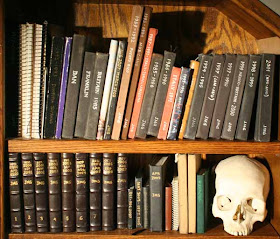Norman Rockwell went to great lengths to get his models to act. He spared no expense in hiring photographers to document their performances. The resulting photos—20,000 of which are in the Norman Rockwell Museum’s archives and have just been digitized—served as references for most of his famous Post covers after the mid-1930s.

As a
new book and an
upcoming exhibition demonstrates, Rockwell was always conscious of going well beyond the photo, striving for a exaggerated reality to communicate his ideas.
His painting “The Gossips,” 1948 (Oil on canvas, 33” x 31”) is a good example. The 30 heads in the painting pass along a piece of gossip about Mr. Rockwell himself, who confronts the source of the rumor in the last pairing.

The old lady and the young woman with the scarf went through a big transformation from photo to painting. The older woman in the painting is seen more in profile; and her smile is broadened. The younger woman’s eyes and her mouth open wider and her head tilts more forward.

The man in this pairing gets a bigger shock of hair, a pointier nose, and a more wide-open mouth. His neck protrudes from a greatly simplified collar. The woman is brought more into profile, and she’s given a hand.

The man at left loses his hat, probably to avoid duplicating his counterpart. All his expressive features: eyes, eyebrows, and mouth are exaggerated—and he gets a hand with a cigar. The man at right, who appears just before the crescendo of the story, is pushed to the extreme. His chin tucks in, his hat tips to the side, he’s gets a bow tie, and his head takes the shape of a light bulb.
Rockwell also lifts his eyebrows. Hardly any model—except maybe Jim Carrey--can simultaneously drop the jaw, squint the eyes, and lift the eyebrows. It’s not easy; try it! But it looks right, and Rockwell got it in the final.
Rockwell always wrestled with his conscience over his use of the camera and the projector, which he called “an evil, inartistic, habit-forming, lazy, and vicious machine.”
But he should have been easier on himself, because he really set a good example to the rest of us about how to use photos intelligently. He rarely forgot his initial conception, and he only used the photos as a starting point.
As he said in his classic work “Rockwell on Rockwell,” 1949, “I feel that the characters which I produce in this way more nearly express those which I have in my mind and which I am trying to portray.”
------
More about new book Norman Rockwell Behind the Camera, by Ron Schick on
Amazon.The exhibition: Norman Rockwell Behind the Camera will run at the Norman Rockwell Museum from November 7 – May 31, 2010,
link for more info.There’s an article in this month’s Vanity Fair with lots of images and a surprisingly respectful biographical overview.
 They dramatically illustrate a point that you can observe more subtly in almost any group of buildings or structures: Things settle a bit and get out of alignment over time. Or they weren’t built perfectly in the first place, especially before the laser-beam era.
They dramatically illustrate a point that you can observe more subtly in almost any group of buildings or structures: Things settle a bit and get out of alignment over time. Or they weren’t built perfectly in the first place, especially before the laser-beam era. 
















































